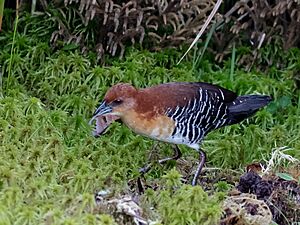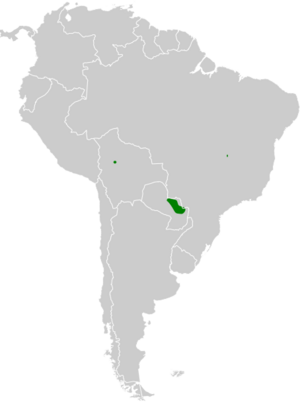Rufous-faced crake facts for kids
Quick facts for kids Rufous-faced crake |
|
|---|---|
 |
|
| Conservation status | |
| Scientific classification | |
| Genus: |
Laterallus
|
| Species: |
xenopterus
|
 |
|
The rufous-faced crake (Laterallus xenopterus) is a small bird. It belongs to the Rallidae family. This family includes rails, gallinules, and coots. You can find this special bird in Bolivia, Brazil, and Paraguay.
Contents
About the Rufous-faced Crake
What it Looks Like
The rufous-faced crake is about 14 centimeters (5.5 inches) long. It weighs around 52 grams (1.8 ounces). Both male and female crakes look the same. They have a blue-gray beak, legs, and feet.
Their face, the back of their neck, and their upper back are a reddish-brown color. This color is called rufous. Their throat and belly are white. The front of their neck and chest are a buffy yellow-brown.
Their wings and sides have cool black and white stripes. Their tail and the feathers under their tail are black.
Where it Lives
The rufous-faced crake lives in parts of Bolivia, Brazil, and Paraguay. It prefers marshy areas. These are wet lands with lots of grass. They especially like places with moist, clumpy grass or matted grass.
Scientists think this bird might live in more places than we know. This is because there are many suitable habitats around.
How it Behaves
Not much is known about the rufous-faced crake's daily life. Scientists are still learning about them.
What it Eats
We don't know exactly what the rufous-faced crake eats. We also don't know how it finds its food.
Sounds it Makes
The rufous-faced crake has a unique song. It sounds like a long, soft trill that goes down in pitch. It also makes gentle "piú piú" calls.
Protecting the Rufous-faced Crake
The rufous-faced crake is considered a vulnerable species. This means it is at risk of becoming endangered. The IUCN (International Union for Conservation of Nature) keeps track of species like this.
There are not many of these birds left. Scientists estimate there are only 2,500 to 10,000 adult crakes. Their numbers are believed to be shrinking.
The biggest problem for these birds is losing their homes. Their marshy habitats are being turned into farms. People grow crops like corn and soybeans there. Forests are also being planted with trees like eucalyptus.
Another big threat is the use of chemicals. Things like pesticides and fertilizers can harm the birds and their environment. Protecting their homes is very important to help these special birds survive.


